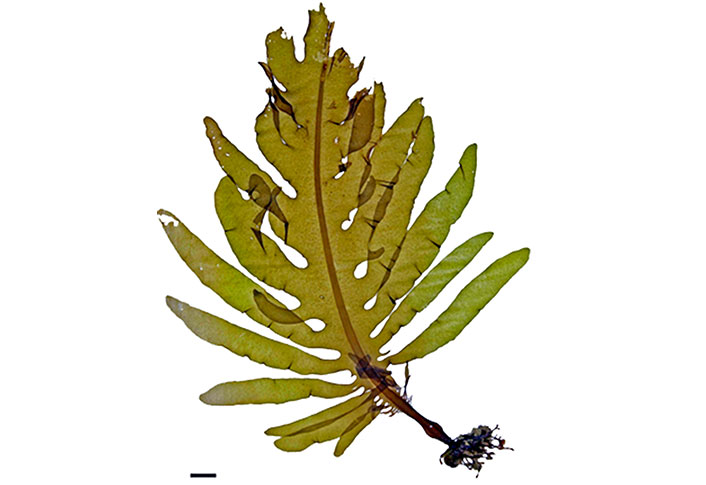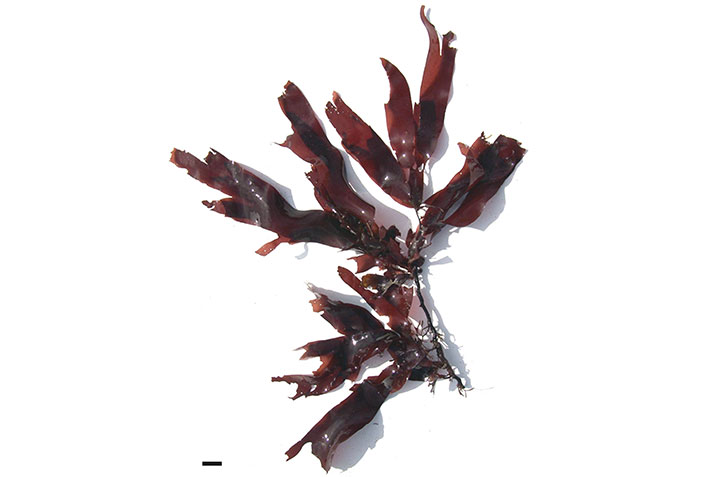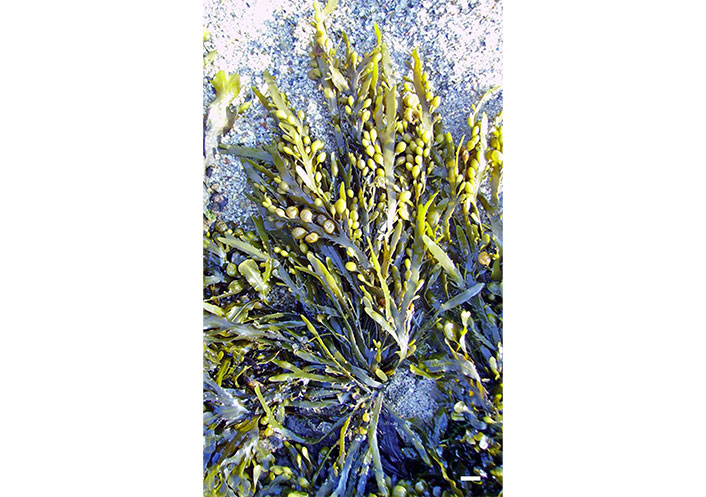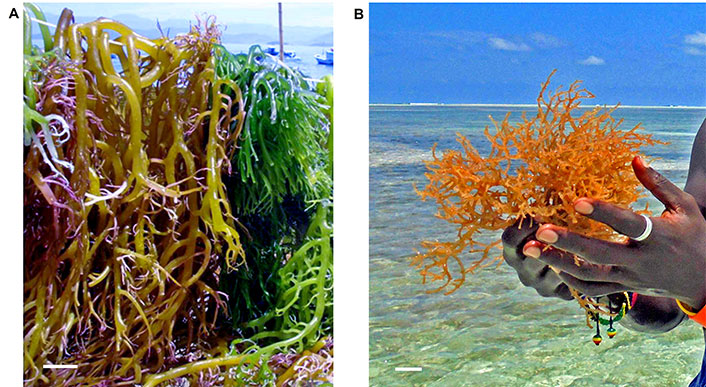Abstract
Seaweed, a rich source of bioactive compounds, has gained increasing attention for its potential therapeutic applications in allergy and inflammation. This review examines the current scientific literature investigating the effects of seaweed derived food and diet factors on allergic and inflammatory conditions. Seaweed is abundant in polysaccharides, peptides, polyphenols, and fatty acids, which possess anti-inflammatory, antioxidant, and immunomodulatory properties. These bioactive compounds have the capacity to modulate immune responses and mitigate allergic reactions, rendering seaweed a promising candidate for the development of functional foods and dietary interventions targeting allergy and inflammation. Explorations into the effects of seaweed consumption on allergic conditions such as allergic rhinitis, asthma, and atopic dermatitis have shown encouraging results. Factors found in seaweed have the potential to alleviate symptoms, reduce inflammation, and boost immune function in allergy sufferers. Furthermore, inquiries into the effectiveness of diets incorporating seaweed in preventing and managing chronic inflammatory conditions like inflammatory bowel disease and rheumatoid arthritis have been undertaken. The mechanisms underlying the therapeutic effects of seaweed derived compounds are being unraveled, revealing their ability to modulate immune cell activity, regulate cytokine production, inhibit inflammatory mediators, and promote gut microbiota balance. Understanding these molecular mechanisms is crucial for targeted interventions and the identification of specific bioactive compounds responsible for the observed therapeutic effects. Seaweed derived food and diet factors hold significant promise as natural interventions for the prevention and management of allergic and inflammatory conditions. However, further research is required to establish the optimal dosage, formulation, and long-term effects of seaweed-based interventions. Additionally, clinical trials are necessary to validate their efficacy and safety in diverse patient populations. This review emphasizes the therapeutic potential of seaweed derived compounds and underscores the importance of incorporating seaweed into dietary strategies to combat allergy and inflammation.
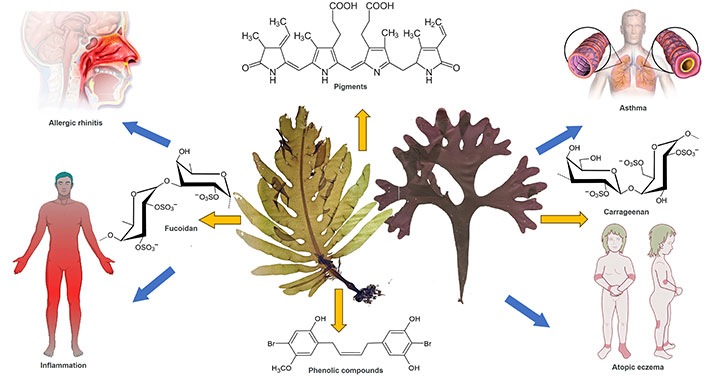
Bioactive compounds present in algae and their potential health benefits. The figure was partially created with biorender.com
Keywords
Seaweed derived, food, diet factors, therapeutic potential, allergy, inflammation, bioactive compoundsIntroduction
Overview of allergic asthma, rhinitis, and atopic eczema as prominent atopic diseases
Understanding and addressing allergy and inflammation is crucial due to their widespread prevalence, profound impact on individuals’ well-being, and the complex mechanisms underlying conditions like allergic asthma, rhinitis, and atopic eczema. These conditions stem from abnormal immune responses to otherwise harmless substances, leading to chronic inflammation and debilitating symptoms. Exploring the intricate pathways and pathophysiology involved in these diseases, which combine genetic predisposition and environmental factors, is essential for developing effective therapeutic strategies. By delving into the mechanisms driving these immune responses and chronic inflammation, it becomes possible to identify potential targets for intervention and innovative treatments. Furthermore, given the increasing burden these conditions pose on healthcare systems and the quality of life for affected individuals, a comprehensive understanding of allergy and inflammation is fundamental in shaping advancements that alleviate symptoms, tackle immune dysregulation, and ultimately improve the management and outcomes of these atopic diseases [1].
Allergic asthma, rhinitis, and atopic eczema are among the most prevalent atopic diseases worldwide, affecting a significant number of individuals [2]. These conditions are characterized by an abnormal immune response to harmless substances, known as allergens, resulting in chronic inflammation and associated symptoms [3]. Allergic asthma manifests as recurrent episodes of wheezing, coughing, and difficulty breathing, triggered by specific allergens such as pollen, dust mites, or pet dander [4]. Rhinitis, commonly referred to as hay fever, causes nasal congestion, sneezing, and itching, and is often associated with allergic asthma [5]. Atopic eczema, or atopic dermatitis (AD), is a chronic inflammatory skin disorder characterized by itchy, red, and dry patches, which can significantly impact an individual’s quality of life [6].
These atopic diseases have a complex etiology involving a combination of genetic predisposition and environmental factors. The immune system of individuals with atopic diseases is hypersensitive to certain allergens, leading to an exaggerated immune response characterized by the release of pro-inflammatory molecules and activation of immune cells [6, 7]. This immune response results in chronic inflammation in the affected tissues, leading to the hallmark symptoms observed in allergic asthma, rhinitis, and atopic eczema [8].
The prevalence of these atopic diseases has been steadily increasing over the past decades, posing a significant burden on healthcare systems and individuals’ well-being. Allergic asthma, rhinitis, and atopic eczema can have a profound impact on daily activities, sleep quality, and overall quality of life. Additionally, these conditions often coexist, suggesting shared underlying mechanisms and a common atopic diathesis [9, 10].
Given the rising prevalence and impact of allergic asthma, rhinitis, and atopic eczema, there is a need for effective therapeutic approaches [11]. Conventional treatments primarily focus on symptom management, including the use of bronchodilators, antihistamines, and topical corticosteroids [12]. However, emerging research has explored alternative avenues [13], such as the potential therapeutic benefits of natural compounds derived from sources like seaweed. These compounds, rich in bioactive components with anti-inflammatory and immunomodulatory properties, hold promise for their potential in modulating immune responses and attenuating allergic inflammation [13, 14].
This overview sets the stage for further exploration of the therapeutic potential of seaweed derived food and diet factors in addressing the symptoms and underlying immune dysregulation associated with allergic asthma, rhinitis, and atopic eczema [15]. Through attaining a more profound comprehension of these conditions and exploring innovative therapeutic approaches, novel strategies to enhance the management and quality of life for individuals affected by these atopic diseases may be discovered [16].
Growing significance of algae derived food as a therapeutic measure
Algae derived food has gained increasing significance as a therapeutic measure due to its rich composition of bioactive compounds with potential health benefits [17]. Seaweed, a type of marine algae, has been consumed in various cultures for centuries and is now being recognized as a valuable source of nutrients and functional compounds [18].
Algae are rich in polysaccharides, peptides, polyphenols, and fatty acids, which possess a wide range of bioactivities [19]. These bioactive compounds have been shown to exhibit anti-inflammatory, antioxidant, antiviral, antibacterial, and immunomodulatory properties [19, 20]. Such properties make seaweed an attractive candidate for therapeutic applications in various health conditions [20].
In the context of allergic diseases and inflammation, algae derived food and diet factors have shown promising potential. Research has indicated that these compounds can modulate immune responses, attenuate allergic reactions, and reduce inflammation [21]. The anti-inflammatory effects of seaweed derived compounds have been demonstrated in preclinical and clinical studies, suggesting their ability to inhibit the production of inflammatory mediators and modulate immune cell activity [21, 22].
Moreover, the bioactive compounds in algae have been implicated in the regulation of gut microbiota, which plays a crucial role in immune function and overall health. By promoting a healthy balance of gut microbiota, seaweed derived food may help modulate immune responses and contribute to the prevention and management of allergic and inflammatory conditions. Another advantage of seaweed derived food is its potential as a sustainable and environmentally friendly dietary option. Seaweed requires minimal resources for cultivation, such as water, sunlight, and nutrients, and it has a high growth rate. This makes it an attractive alternative to land-based agriculture, which often contributes to environmental degradation and resource depletion [23, 24].
Overall, the growing significance of algae derived food as a therapeutic measure lies in its bioactive composition and potential to modulate immune responses and inflammation [25]. With further research and exploration, seaweed-based interventions may provide innovative and sustainable approaches to promote health, prevent allergic diseases, and manage inflammatory conditions [26].
Allergic asthma, rhinitis, and atopic eczema: pathophysiology and mechanisms
Brief explanation of the immunological basis of these diseases
Allergic asthma, rhinitis, and atopic eczema are characterized by dysregulated immune responses, specifically involving the immune system’s allergic or atopic arm. These diseases have an immunological basis rooted in an exaggerated immune response to normally harmless substances, known as allergens [27, 28].
In allergic asthma, the immune system overreacts to inhaled allergens such as pollen, dust mites, or pet dander. When these allergens enter the respiratory system, immune cells known as mast cells, which are abundantly present in the airways, become sensitized [29, 30]. Upon subsequent exposure to the same allergen, the sensitized mast cells release inflammatory mediators, including histamine, leukotrienes, and cytokines. This release triggers a cascade of events, leading to airway inflammation, bronchoconstriction, mucus production, and the characteristic symptoms of wheezing, coughing, and shortness of breath [31, 32].
Rhinitis, commonly referred to as hay fever, shares similarities with allergic asthma in terms of the underlying immunological mechanisms. In allergic rhinitis, allergens such as pollen or mold spores are inhaled and trigger an allergic response in the nasal mucosa. Mast cells in the nasal lining release inflammatory mediators, resulting in symptoms such as nasal congestion, sneezing, itching, and a runny nose [5, 33].
Atopic eczema, or AD, is a chronic inflammatory skin disorder associated with a disrupted skin barrier and immune dysregulation [34]. In individuals with atopic eczema, the skin is more susceptible to irritants and allergens, leading to increased inflammation [35]. The immune response in atopic eczema involves both innate and adaptive immunity. Immune cells, such as mast cells and dendritic cells, play a role in recognizing and responding to allergens. Activation of these immune cells triggers the release of pro-inflammatory molecules, leading to skin inflammation, itching, and the characteristic rash [36, 37].
Underlying these allergic diseases is an imbalance between T helper type 1 (Th1, cell-mediated) and Th2 (humoral) immune responses. In individuals prone to atopic diseases, there is an overactivation of the Th2 arm of the immune system, characterized by the production of specific cytokines such as interleukin-4 (IL-4), IL-5, and IL-13. These cytokines promote the production of allergen-specific immunoglobulin E (IgE) antibodies and enhance the recruitment and activation of other immune cells involved in allergic inflammation [38, 39]. Additionally, there is growing recognition of the role of other immune cells, such as regulatory T cells (Tregs) and innate lymphoid cells (ILCs), in modulating the immune response in these allergic diseases. Tregs help maintain immune tolerance and prevent excessive immune reactions, while ILCs contribute to the initiation and regulation of immune responses at barrier sites, including the respiratory and skin mucosa [40, 41].
Understanding the immunological basis of allergic asthma, rhinitis, and atopic eczema is essential for developing targeted therapeutic strategies that can modulate immune responses, reduce inflammation, and restore immune balance in individuals affected by these conditions [42, 43].
Role of inflammation in disease development and progression
Inflammation plays a significant role in the development and progression of various diseases. It is a complex biological response that occurs when the body’s immune system detects injury, infection, or tissue damage [44]. While acute inflammation is a necessary and beneficial response for initiating healing and fighting infections, chronic or excessive inflammation can have detrimental effects on the body [45].
In many diseases, including autoimmune disorders, cardiovascular diseases, neurodegenerative conditions, and certain types of cancer, chronic inflammation is a key contributor to disease development and progression. Here are some ways in which inflammation influences disease processes [46].
Inflammation involves the recruitment of immune cells, such as neutrophils, macrophages, and lymphocytes, to the affected site. These cells release inflammatory mediators, such as cytokines, chemokines, and reactive oxygen species, which can cause tissue damage and disrupt normal cellular function [47].
Chronic inflammation can result in an imbalance in the immune system, with an excessive activation of pro-inflammatory pathways and a decrease in anti-inflammatory responses. This dysregulation can lead to an overactive immune response, tissue destruction, and impaired immune surveillance against infections or cancer cells [48].
Inflammatory processes can generate an increased production of reactive oxygen species and free radicals, leading to oxidative stress. Oxidative stress can damage cellular components, including DNA, proteins, and lipids, contributing to cellular dysfunction and the development of chronic diseases [49].
Chronic inflammation can stimulate the growth of new blood vessels (angiogenesis) and promote tissue remodeling. While angiogenesis is important for wound healing, excessive or abnormal blood vessel growth can contribute to diseases such as rheumatoid arthritis and cancer [50].
Inflammatory mediators can disrupt normal cell signaling pathways, leading to abnormal cell proliferation, differentiation, and survival. This can contribute to the development of cancer and other proliferative diseases [51].
Inflammation can induce epigenetic changes, altering gene expression patterns without altering the underlying DNA sequence. These modifications can influence disease susceptibility and progression by regulating inflammation-related genes and pathways [52].
Managing and controlling inflammation is an important therapeutic strategy for many diseases. Anti-inflammatory drugs, immunomodulatory therapies, lifestyle modifications (e.g., healthy diet, regular exercise), and stress reduction techniques can help mitigate chronic inflammation and improve disease outcomes. Understanding the role of inflammation in disease development and progression allows for the development of targeted interventions aimed at reducing inflammation and restoring immune balance to promote overall health and well-being [53, 54].
Algae derived food: composition and bioactive components
Overview of different types of seaweed and their nutritional profiles
Seaweed (marine macroalgae) encompasses a diverse group of marine algae that are classified into different types based on their pigmentation, structure, and habitat [55]. The nutritional profiles of seaweed vary among species, but they generally share some common characteristics that make them valuable as a source of nutrients and bioactive compounds [56]. In the context of exploring the therapeutic potential of seaweed derived food and diet factors in allergy and inflammation, understanding the nutritional profiles of different seaweed types is crucial [26]. Here is an overview of some commonly consumed seaweed types and their nutritional profiles.
Nori (Porphyra spp.) (Figure 1) is a red alga commonly used in sushi rolls and other Asian dishes. It is known for its high protein content, along with essential amino acids, vitamins (vitamin A, vitamin C, and vitamin B12), and minerals (iron, calcium, and iodine). Nori also contains omega-3 fatty acids and specific polysaccharides with potential immunomodulatory and anti-inflammatory properties [57].
Kelp (Laminaria spp. and Saccharina spp.) (Figure 2) are brown algae that grow in underwater forests. It is rich in dietary fiber, particularly soluble fibers like alginate, which can help modulate gut health and regulate immune responses. Kelp is also a good source of vitamins (vitamin K, vitamin A, and vitamin C), minerals (iodine, potassium, and magnesium), and antioxidants, such as fucoxanthin, which has demonstrated anti-inflammatory properties [58].
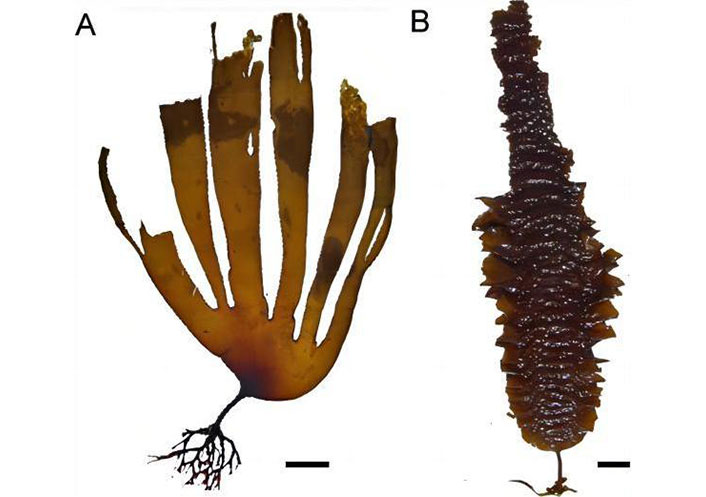
Brown macroalgae. (A) Laminaria (kombu); (B) Saccharina (kombu real). Scale bar = 5 cm
Wakame (Undaria pinnatifida) (Figure 3) is a brown alga commonly used in Japanese cuisine. It is low in calories and fat but contains significant amounts of minerals, including calcium, magnesium, and iron. Wakame is also a source of fucoxanthin, which has shown anti-inflammatory and anti-allergic properties in preclinical studies [59].
Spirulina (Arthrospira spp.) is a blue-green microalgae that is widely recognized for its high protein content, containing all essential amino acids. It is also a rich source of vitamins (vitamin B12, vitamin A, and vitamin K) and minerals (iron, potassium, and calcium). Spirulina contains phycocyanin, a pigment with antioxidant and anti-inflammatory properties that may contribute to its potential therapeutic effects [60].
Dulse (Palmaria palmata) (Figure 4) is a red alga that is often consumed dried or used as a seasoning. It is rich in minerals like iodine, iron, and potassium. Dulse also contains antioxidant compounds, such as polyphenols, which have been associated with anti-inflammatory effects [61].
These are just a few examples of seaweed types and their nutritional profiles. Algae derived food and diet factors offer a wide range of nutrients, including proteins, vitamins, minerals, and bioactive compounds that have the potential to modulate immune responses and alleviate inflammation [56]. Incorporating different types of seaweed into the diet can provide a diverse array of beneficial nutrients, which may contribute to the therapeutic potential of seaweed in addressing allergy and inflammation-related conditions [62].
Bioactive compounds present in algae and their potential health benefits
Algae, including seaweed, are rich sources of bioactive compounds that offer various potential health benefits. These compounds contribute to the therapeutic potential of algae in promoting overall well-being and addressing specific health conditions [63].
Algae contain a variety of polysaccharides, such as alginate, carrageenan, and fucoidan. These polysaccharides possess immunomodulatory, anti-inflammatory, and antioxidant properties. They may help regulate immune responses, reduce inflammation, and scavenge free radicals, thereby potentially benefiting conditions related to allergy and inflammation [64].
Phycobiliproteins are protein-pigment complexes found in certain types of algae, such as spirulina. These compounds, including phycocyanin and allophycocyanin, exhibit antioxidant, anti-inflammatory, and neuroprotective properties. They may help combat oxidative stress, reduce inflammation, and support brain health [65].
Macroalgae, particularly brown algae, are abundant sources of polyphenols, including flavonoids, phenolic acids, and phlorotannins. Polyphenols possess antioxidant, anti-inflammatory, and anticancer properties. They may contribute to the prevention of chronic diseases, such as cardiovascular diseases, cancer, and neurodegenerative disorders [66].
Some types of algae, such as microalgae [e.g., Isochrysis (Coccolithophyceae), Tetraselmis (Chlorophyta), Nannochloropsis (Eustigmatophyceae), Chaetoceros and Thalassiosira (Bacillariophyta)], are rich in omega-3 fatty acids, specifically eicosapentaenoic acid (EPA) and docosahexaenoic acid (DHA). These essential fatty acids have been associated with cardiovascular health, cognitive function, and anti-inflammatory effects [67].
Fucoxanthin is a carotenoid pigment present in brown algae, like, for example, Padina, Sargassum, Turbinaria, Cystoseira, Ecklonia (Figure 5), Undaria, Saccharina, etc. It exhibits antioxidant, anti-inflammatory, and anti-obesity properties. Fucoxanthin has been studied for its potential in weight management, metabolic health, and as an adjunct therapy for various conditions [68].
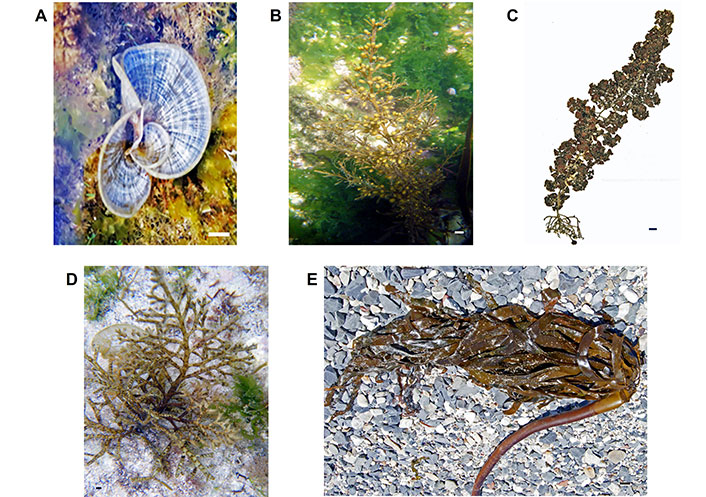
Brown macroalgae. (A) Padina; (B) Sargassum; (C) Turbinaria; (D) Cystoseira; (E) Ecklonia. Scale bar = 1 cm
Algae are excellent sources of vitamins, including vitamin A, vitamin C, vitamin K, and certain B vitamins. Freshwater [Anabaena cylindrica, Anthrispira maxima (Cyanobacteria), Dunaliella, Haematococcus, Chlorella, Parachlorella, and Tetradesmus obliquus (Chlorophyta)] and marine algae [Dunaliella salina (Chlorophyta), Rhodomonas salina (Cryptophyceae), and Nannochloropsis oceanica (Eustigmatophyceae)] possess the capability to produce various vitamins and provitamins that are valuable in the cosmeceuticals industry. The synthesis and abundance of these vitamins are influenced by factors such as the specific algal species, environmental conditions like nutrition, light, temperature, potential of hydrogen (pH), and trace elements, as well as the photoperiod, growth phase, and conditions during harvesting. They also provide minerals like iodine, calcium, magnesium, and iron, which are essential for various physiological functions in the body [69, 70].
These bioactive compounds present in algae contribute to their potential health benefits, such as antioxidant activity, anti-inflammatory effects, immune modulation, and support for specific organ systems [71]. However, it is important to note that the therapeutic effects and optimal dosage of algae derived bioactive compounds may vary depending on the specific compound, algae species, and individual health conditions. Further research, including clinical trials, is needed to better understand the mechanisms and therapeutic potential of these compounds and their specific applications in addressing various health concerns [72, 73].
Mechanisms through which seaweed derived food may modulate allergy and inflammation
Algae derived food has shown promise in modulating allergy and inflammation through several mechanisms [74, 75]. While further research is needed to fully understand these mechanisms, here are some potential ways in which algae derived food may exert its effects.
Algae derived compounds, such as polysaccharides and phycobiliproteins, have been found to modulate immune responses [76]. They can interact with immune cells and signaling pathways, influencing the production and activity of immune mediators. These compounds may help regulate the balance between pro-inflammatory and anti-inflammatory responses, thereby attenuating excessive immune reactions associated with allergies and inflammation [22, 76].
Algae contain bioactive compounds, including polyphenols and omega-3 fatty acids, which possess anti-inflammatory properties. They can inhibit the production of pro-inflammatory mediators, such as cytokines and prostaglandins, and suppress the activation of inflammatory pathways, such as nuclear factor kappa-light-chain-enhancer of activated B cells (NF-κB). By reducing inflammation, algae derived food may alleviate symptoms associated with allergies and inflammatory conditions [22, 77].
Algae are rich in antioxidants, including phycobiliproteins, polyphenols, and carotenoids like fucoxanthin. These compounds can scavenge free radicals and reduce oxidative stress, which is often associated with allergic reactions and chronic inflammation. By protecting cells from oxidative damage, algae derived food may help mitigate inflammation and promote overall health [78, 79].
Algae derived food can influence the composition and activity of the gut microbiota, which plays a crucial role in immune regulation and inflammation [80]. Certain compounds in algae, such as polysaccharides and dietary fibers, can serve as prebiotics, promoting the growth of beneficial bacteria in the gut. A balanced and diverse gut microbiota can contribute to immune homeostasis and reduce inflammation [81].
Algae derived compounds, particularly polysaccharides like alginate and carrageenan, have been studied for their potential to enhance the integrity of epithelial barriers, such as the respiratory and gut mucosa [82]. By improving barrier function, algae derived food may help prevent the penetration of allergens and pathogens, reducing the risk of allergic reactions and inflammation [82, 83].
Some algae, such as Spirulina, are rich in omega-3 fatty acids and bioactive lipids. These compounds can influence lipid metabolism and the production of lipid mediators, such as eicosanoids, that are involved in inflammatory processes. By modulating lipid metabolism, algae derived food may exert anti-inflammatory effects and help restore lipid balance associated with inflammatory conditions [13, 84].
It is important to note that the specific mechanisms through which algae derived food modulates allergy and inflammation may vary depending on the type of algae, the bioactive compounds present, and the individual’s unique physiological factors. Further research is needed to elucidate these mechanisms and optimize the use of algae derived food as a therapeutic approach for allergies and inflammatory conditions [74, 80].
Identification of key algae derived nutrients and bioactive compounds with anti-allergic and anti-inflammatory properties
Several key algae derived nutrients and bioactive compounds have been identified for their potential anti-allergic and anti-inflammatory properties [22, 26]. These compounds have shown promising effects in modulating immune responses, reducing inflammation, and alleviating allergic symptoms [22, 26, 71].
Fucoidan is a sulfated polysaccharide found in brown algae, such as kombu and wakame. It has demonstrated anti-allergic and anti-inflammatory effects by inhibiting the release of histamine and other inflammatory mediators from mast cells. Fucoidan can also modulate immune responses and downregulate pro-inflammatory cytokines [85, 86].
Phycocyanin is a blue pigment found in Spirulina and other blue-green algae. It exhibits antioxidant and anti-inflammatory properties and has shown the potential in suppressing allergic reactions and reducing inflammation in preclinical studies [87, 88].
Algae, including brown macroalgae, are rich sources of polyphenolic compounds. These compounds, such as phlorotannins, exhibit antioxidant and anti-inflammatory activities. They can scavenge free radicals, inhibit inflammatory pathways, and modulate immune responses, thereby potentially alleviating allergy, and inflammation-related symptoms [89, 90].
Certain varieties of algae, notably microalgae such as Chlorella (Chlorophyta) and Schizochytrium (Thraustochytriaceae), represent superb reservoirs of omega-3 fatty acids, particularly EPA and DHA. These fatty acids have been shown to possess anti-inflammatory properties and may help mitigate allergic reactions and inflammation by modulating immune responses and reducing the production of pro-inflammatory molecules [91, 92].
Astaxanthin is a carotenoid pigment present in certain types of algae, including Haematococcus lacustris (Chlorophyta). It exhibits potent antioxidant and anti-inflammatory effects. Astaxanthin has been investigated for its potential in alleviating allergic inflammation and reducing symptoms associated with asthma and rhinitis [93].
Algae derived polysaccharides, such as alginate, fucoidan [extracted, for example, from Undaria pinnatifida and Ascophyllum nodosum (Phaeophyceae)] (Figure 6), and carrageenan [extracted, for example, from Kappaphycus and Eucheuma (Rhodophyta)] (Figure 7), have shown immunomodulatory and anti-inflammatory properties [94]. They can interact with immune cells, modulate cytokine production, and suppress inflammatory pathways, thereby attenuating allergic responses and inflammation [94, 95]. Carrageenan showcases promising immunomodulatory and anti-inflammatory traits in studies, demonstrating interactions with immune cells to modulate cytokine production and mitigate allergic responses [49]. However, a segment of the population might experience gastrointestinal discomfort upon its consumption, manifesting as bloating, gas, or diarrhea. Sensitivity reactions are reported in certain individuals, leading to more pronounced digestive issues even with minimal carrageenan intake. Although carrageenan is considered safe in limited quantities by regulatory bodies, controversies persist regarding its potential inflammatory effects, especially in degraded forms used in research. This variability in responses highlights the need for further investigation into its impact on human health, prompting some food manufacturers to seek alternatives or reformulate products, while individuals with sensitivities are advised to monitor their intake or consult healthcare professionals for guidance [49].
These are just a few examples of key nutrients and bioactive compounds found in algae that have demonstrated anti-allergic and anti-inflammatory properties. However, it’s important to note that the efficacy and specific mechanisms of action may vary depending on the type of algae, extraction methods, dosage, and individual variations [96]. Further research, including clinical studies, is necessary to fully understand the potential of these compounds and their applications in managing allergies and inflammatory conditions [73].
Seaweed as an external therapeutic approach in atopic eczema
Seaweed has gained interest as an external therapeutic approach to managing atopic eczema, offering potential benefits for the skin affected by this condition [97]. Here are some ways in which seaweed may be used as an external therapy for atopic eczema (see Table 1).
Algae used in atopic eczema therapy
| Species | Compounds | Activity | References |
|---|---|---|---|
| Ascophyllum nodosum (Phaeophyceae)Lithothamnium (Rhodophyta) | Silver-loaded seaweed-based cellulosic fiber | Improves epidermal skin physiology in AD in an in vivo study | [98] |
| Capsosiphon fulvescens (Chlorophyta) | Seaweed extract | Extract (200 mg/mouse) inhibited the development of AD symptom | [99] |
| Chlorella stigmatophora (Chlorophyta) | Crude polysaccharide extract | Anti-inflammatory and immunomodulatory activities | [100] |
| Ecklonia cava (Phaeophyceae) | Phlorotannins | Anti-inflammatory activities | [101] |
| Eisenia nipponica (Phaeophyceae) | Phlorotannins | Alleviate allergic inflammation in AD | [102] |
| Fucus vesiculosus (Phaeophyceae) | Fucoidan | Topical skin brightening and anti-aging formulations | [103] |
| Haematococcus lacustris (Chlorophyta) | Astaxanthin | In vitro and in vivo anti-inflammatory and antioxidant activities | [104] |
| Kappaphycus alvarezii (Rhodophyta) | Carrageenan | Antioxidant and tyrosinase enzyme inhibitory activities | [105] |
| Nannochloropsis oculata (Eustigmatophyceae) | 80% methanolic extract | Sterols provide a promising role in future medicines with anti-inflammatory activity | [106] |
| Phaeodactylum tricornutum (Bacillariophyceae) | Crude polysaccharide extract | Anti-inflammatory and immunomodulatory activities | [107] |
| Sargassum horneri (Phaeophyceae) | Polyphenol-rich extracts | Alleviates AD-like skin lesions in NC/Nga mice | [108] |
| Sargassum plagiophyllum (Phaeophyceae) | Alginate | Antioxidant and tyrosinase enzyme inhibitory activities | [105] |
| Sargassum polycystum (Phaeophyceae) | Phlorotannins | Topical application alleviated symptoms by activating anti-inflammatory and antioxidative stress and by promoting the healing process | [101] |
| Undaria pinnatifida (Phaeophyceae) | Extract | Skin-protecting and anti-aging properties | [103] |
Skin hydration and moisturization
Seaweed extracts contain natural moisturizing compounds, such as polysaccharides and amino acids, which can help improve skin hydration and prevent moisture loss. By providing hydration to the skin, seaweed-based products may alleviate dryness and itching commonly associated with atopic eczema [97].
Anti-inflammatory properties
Certain bioactive compounds found in seaweed, such as phlorotannins and fucoidan, possess anti-inflammatory effects. These compounds can help reduce skin inflammation, redness, and irritation associated with atopic eczema. By calming the skin, seaweed-based treatments may provide relief from symptoms [97, 109].
Skin barrier support
Atopic eczema is characterized by a compromised skin barrier, which allows allergens and irritants to penetrate the skin more easily. Seaweed extracts can help support the skin barrier function by providing essential nutrients, such as vitamins and minerals, and promoting the synthesis of structural proteins like collagen and elastin. Strengthening the skin barrier may help reduce the severity of atopic eczema symptoms and protect the skin from further damage [110].
Antimicrobial effects
Some species of seaweed [Gelidium corneum (Rhodophyta)] (Figure 8) have demonstrated antimicrobial properties, inhibiting the growth of certain bacteria and fungi. This can be beneficial in atopic eczema, as individuals with this condition are more prone to skin infections. Seaweed-based treatments may help prevent secondary infections and maintain skin health [111].
Antioxidant activity
Seaweed [Fucus spiralis (Phaeophyceae)] (Figure 9) is rich in antioxidants, including vitamins, minerals, and polyphenols, which can help neutralize free radicals and reduce oxidative stress. This antioxidant activity may protect the skin from damage and support its overall health in atopic eczema [79].
It’s worth noting that the use of seaweed as an external therapeutic approach in atopic eczema is still an area of ongoing research. Different species of seaweed and formulations may have varying effects, and individual responses may differ. It is advisable to consult with a dermatologist or healthcare professional before incorporating seaweed-based treatments into your skincare regimen for atopic eczema [97, 99, 112, 113].
Conclusions
The current evidence suggests that algae derived food may have potential benefits in managing allergies and inflammation [114]. Algae, such as Spirulina and Chlorella, are rich sources of nutrients, including vitamins, minerals, and antioxidants, which have been shown to possess anti-inflammatory and immunomodulatory properties [80]. Several studies have demonstrated that consuming algae derived supplements or incorporating algae-based ingredients into the diet can reduce allergic symptoms and inflammation in various conditions [80, 114].
Research has highlighted the ability of algae derived food to modulate the immune response and regulate the release of inflammatory mediators [71]. These properties may be attributed to the presence of bioactive compounds like phycocyanin, polysaccharides, and carotenoids found in algae. These compounds exhibit anti-inflammatory effects by inhibiting pro-inflammatory cytokines and enzymes, and by enhancing antioxidant defenses [13, 22, 71].
Furthermore, studies have indicated that algae derived food may reduce allergic symptoms by suppressing allergic reactions, modulating immune cell activity, and enhancing the production of anti-inflammatory molecules [75, 76]. The specific mechanisms underlying these effects are still being explored, but initial findings suggest that algae derived compounds may interact with immune cells and signaling pathways involved in allergic responses [15, 22, 75, 76].
However, it is important to note that while algae derived food shows promise in managing allergies and inflammation, further research is needed to establish its effectiveness and safety. Many of the existing studies are limited by small sample sizes, variations in dosages, and variations in algae species and preparations used. Therefore, larger and more rigorous clinical trials are necessary to validate these findings and determine optimal dosages and long-term effects [73, 115, 116].
The current evidence regarding algae derived food and its role in allergy and inflammation has important implications for clinical practice. Healthcare professionals should be aware of the potential benefits of incorporating algae-based products into dietary interventions for patients with allergies and inflammatory conditions. Algae derived food may serve as a complementary approach to traditional therapies, providing additional support in managing symptoms and reducing inflammation [26, 80, 117].
The findings suggest that healthcare professionals can consider recommending algae derived supplements or incorporating algae-based ingredients into patients’ diets to potentially alleviate allergic symptoms and modulate inflammatory responses [118]. However, it is crucial to note that personalized recommendations should be made based on individual patient characteristics, including their specific health conditions, medications, and potential allergies or sensitivities [75, 118].
Furthermore, forthcoming advancements in this domain show potential for enhancing understanding and optimizing the utilization of algae derived food in clinical practice. Ongoing research efforts should focus on conducting larger, well-designed clinical trials to establish the efficacy and safety profiles of algae-based interventions. These trials should explore different algae species, standardized preparations, and dosages to determine the most effective formulations [116, 119].
Moreover, additional research is needed to elucidate the underlying mechanisms through which algae derived compounds exert their anti-allergic and anti-inflammatory effects. Understanding these mechanisms in more detail may facilitate the development of targeted therapies and the identification of specific patient populations who would benefit the most from algae derived food interventions [20, 26, 72, 116].
In the future, advancements in technology and cultivation techniques may also contribute to the availability and affordability of algae derived products. This could lead to increased accessibility for patients and expand the potential applications of algae-based interventions in managing allergies and inflammation [120, 121].
Concluding, the implications for clinical practice are that healthcare professionals can consider incorporating algae derived food into dietary interventions for patients with allergies and inflammatory conditions. Future developments in this field should focus on conducting robust clinical trials, investigating underlying mechanisms, and exploring technological advancements to further optimize the use of algae-based interventions in clinical settings [114, 121, 122].
Abbreviations
| AD: | atopic dermatitis |
| IL-4: | interleukin-4 |
| Th1: | T helper type 1 |
Declarations
Author contributions
LP and AV: Conceptualization, Writing—original draft, Writing—review & editing. Both authors read and approved the submitted version.
Conflicts of interest
The authors declare that they have no conflicts of interest.
Ethical approval
Not applicable.
Consent to participate
Not applicable.
Consent to publication
Not applicable.
Availability of data and materials
Not applicable.
Funding
Not applicable.
Copyright
© The Author(s) 2024.

